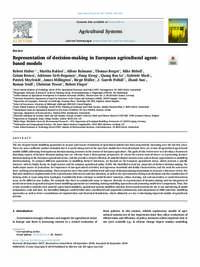Representation of decision-making in European agricultural agent-based models

Authors:
The use of agent-based modelling approaches in ex-post and ex-ante evaluations of agricultural policies has been progressively increasing over the last few years. There are now a sufficient number of models that it is worth taking stock of the way these models have been developed. Here, we review 20 agricultural agent-based models (ABM) addressing heterogeneous decision-making processes in the context of European agriculture. The goals of this review were to i) develop a framework
describing aspects of farmers' decision-making that are relevant from a farm-systems perspective, ii) reveal the current state-of-the-art in representing farmers' decision-making in the European agricultural sector, and iii) provide a critical reflection of underdeveloped research areas and on future opportunities in modelling
decision-making. To compare different approaches in modelling farmers' behaviour, we focused on the European agricultural sector, which presents a specific character with its family farms, its single market and the common agricultural policy (CAP). We identified several key properties of farmers' decision-making: the multi-output nature of production; the importance of non-agricultural activities; heterogeneous household and family characteristics; and the need for concurrent short- and long-term decision-making. These properties were then used to define levels and types of decision-making mechanisms to structure a literature review. We find most models are sophisticated in the representation of farm exit and entry decisions, as well as the representation of long-term decisions and the consideration of
farming styles or types using farm typologies. Considerably fewer attempts to model farmers' emotions, values, learning, risk and uncertainty or social interactions occur in the different case studies. We conclude that there is considerable scope to improve diversity in representation of decision-making and the integration of social interactions in agricultural agent-based modelling approaches by combining existing modelling approaches and promoting model inter-comparisons. Thus, this
review provides a valuable entry point for agent-based modellers, agricultural systems modellers and data driven social scientists for the re-use and sharing of model components, code and data. An intensified dialogue could fertilize more coordinated and purposeful combinations and comparisons of ABM and other modelling approaches as well as better reconciliation of empirical data and theoretical foundations, which ultimately are key to developing improved models of agricultural systems.
